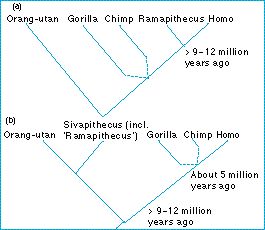The reconstruction of phylogeny - What happens when morphological and molecular methods clash?

This argument was challenged by the molecular evidence.
Sarich and Wilson used an immunological distance measure in which measures how much an antiserum made from the human protein albumin reacts with the albumin of other species.
The degree of cross-reactivity gives a measure of the immunological distance (ID) between a pair of species. ID increases among phylogenetically more distant relatives and at a constant rate through time; it is a sort of molecular clock. The clock can be calibrated using the fossil record for some of the studied species, and the ID can then be used to estimate the divergence time for other pairs of species.
The method suggests that Homo and the other great apes have too short an ID to fit with a pre-Ramapithecusdivergence: Sarich and Wilson suggested humans and chimps diverged only about five million years ago. Subsequent molecular work has supported them.
The corollary is that if Homo diverged from the chimp and gorilla five million years ago, it cannot be more closely related to Ramapithecus than to the living great apes. The phylogeny must be more like that in figure (b) rather than (a).
Figure: relationships of Homo, other great apes and Ramapithecus according to (a) paleontological and (b) molecular (and revised paleontological) evidence. Dotted lines imply uncertainty.
| Next |



